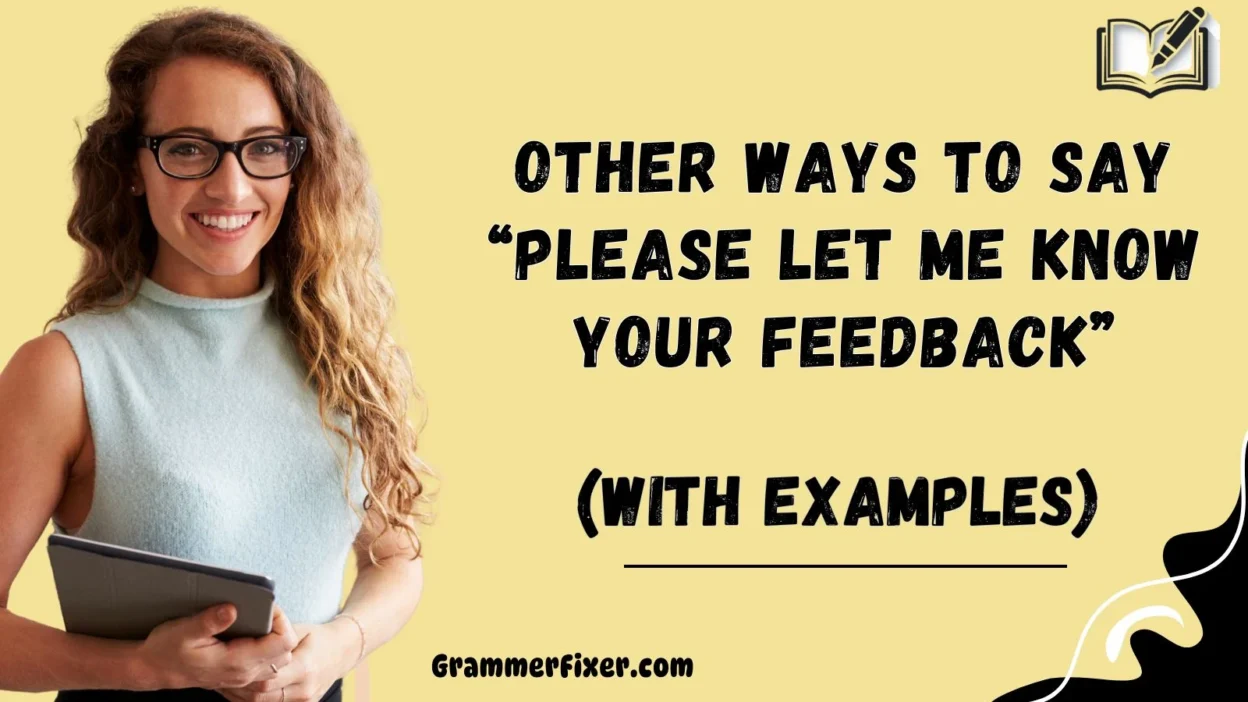Finding the right words when asking for feedback can make a big difference in how your message is received. The phrase “Please let me know your feedback” is commonly used, but sometimes it can feel generic or impersonal. Using thoughtful alternatives can make your emails feel warmer, more engaging, and genuinely appreciative.
In this article, we explore 30 professional and empathetic ways to request feedback in emails, along with explanations, examples, and tips for best use.
What Does “Please Let Me Know Your Feedback” Mean?
At its core, this phrase is a polite request for someone’s thoughts, opinions, or insights about a piece of work, an idea, or a situation. It signals that you value their input and are open to improvements, corrections, or suggestions.
When to Use “Please Let Me Know Your Feedback”?
You can use this phrase or its alternatives when:
- You’ve shared a document, proposal, or project with someone and need their thoughts.
- You’re looking to improve a process, product, or content based on someone’s experience.
- You want to show appreciation for the recipient’s expertise or insight.
Is It Professional/Polite to Say “Please Let Me Know Your Feedback”?
Yes! It’s both professional and polite, but the tone can sometimes feel formal or distant. Using variations can make your communication more personalized and engaging, which is often better received in emails.
Pros and Cons
Pros:
- Clearly communicates you value input.
- Polite and formal enough for professional emails.
- Encourages recipients to share their opinions.
Cons:
- Can feel generic or impersonal if overused.
- Lacks specificity about what kind of feedback you need.
1. I Would Love to Hear Your Thoughts
Meaning: A friendly request for someone’s opinions or ideas.
Explanation: Signals openness and genuine interest in the recipient’s perspective.
Scenario Example: “I would love to hear your thoughts on the attached proposal.”
Best Use: Informal or semi-formal emails to colleagues, teammates, or collaborators.
Worst Use: In highly formal or legal documents, where casual tone might be inappropriate.
Tone: Warm, approachable
2. Your Input Would Be Greatly Appreciated
Meaning: A polite and professional way to ask for someone’s contribution.
Explanation: Shows respect for the recipient’s expertise and time.
Scenario Example: “Your input would be greatly appreciated on the marketing plan draft.”
Best Use: Formal business emails or when reaching out to supervisors or clients.
Worst Use: In informal chats with peers where a casual approach is better received.
Tone: Polite, respectful
3. Could You Provide Your Feedback on This?
Meaning: Directly asking for feedback in a clear manner.
Explanation: Concise and practical, avoids ambiguity.
Scenario Example: “Could you provide your feedback on the report by Friday?”
Best Use: Professional context where clarity is important.
Worst Use: Overly formal in casual team discussions—it may feel stiff.
Tone: Polite, straightforward
4. I’m Eager to Receive Your Feedback
Meaning: Expressing enthusiasm for receiving opinions.
Explanation: Shows genuine interest and positive anticipation.
Scenario Example: “I’m eager to receive your feedback on my presentation slides.”
Best Use: Collaborative or team-based projects.
Worst Use: When recipient is a senior executive or client who may prefer a more neutral tone.
Tone: Friendly, enthusiastic
5. We Value Your Opinions
Meaning: Highlighting the importance of the recipient’s insights.
Explanation: Makes the recipient feel appreciated and respected.
Scenario Example: “We value your opinions on how we can improve our services.”
Best Use: Client or customer communications.
Worst Use: Generic emails where personalization is lacking—it may feel automated.
Tone: Professional, appreciative
6. Please Share Your Insights
Meaning: Inviting detailed thoughts or professional assessment.
Explanation: Suggests you’re looking for substantive input.
Scenario Example: “Please share your insights on the attached research draft.”
Best Use: Academic, professional, or analytical contexts.
Worst Use: Short, casual messages where a long or formal request may feel unnecessary.
Tone: Polite, formal
7. Your Thoughts Would Be Highly Valued
Meaning: Emphasizes the importance of the recipient’s perspective.
Explanation: Makes the recipient feel their feedback carries weight.
Scenario Example: “Your thoughts would be highly valued in shaping this strategy.”
Best Use: Leadership or senior-level communications.
Worst Use: Overused in repetitive requests—it may start feeling insincere.
Tone: Respectful, professional
8. We’re Always Looking to Improve, and Your Feedback Helps
Meaning: Links feedback to improvement and collaboration.
Explanation: Shows a commitment to learning and growth.
Scenario Example: “We’re always looking to improve, and your feedback helps us provide better service.”
Best Use: Customer communications, team retrospectives, or project evaluations.
Worst Use: When used with vague or unrelated requests—it may confuse recipients.
Tone: Friendly, collaborative
9. I Would Appreciate Your Thoughts
Meaning: A polite and considerate request for feedback.
Explanation: Highlights gratitude while inviting input.
Scenario Example: “I would appreciate your thoughts on the draft report before tomorrow’s meeting.”
Best Use: Semi-formal or formal emails where appreciation matters.
Worst Use: Overly casual contexts—it may feel stiff with close colleagues.
Tone: Polite, appreciative
10. Could You Take a Few Moments to Review This?
Meaning: Asking politely for time to provide feedback.
Explanation: Shows respect for the recipient’s schedule.
Scenario Example: “Could you take a few moments to review the attached document and share your feedback?”
Best Use: Professional emails, client communications, or busy colleagues.
Worst Use: If the item is urgent or requires immediate action—may delay response.
Tone: Respectful, considerate
11. I’d Be Grateful for Your Feedback
Meaning: Expressing sincere gratitude for someone’s input.
Explanation: Signals humility and appreciation for the recipient’s effort.
Scenario Example: “I’d be grateful for your feedback on the project plan by Friday.”
Best Use: Formal or semi-formal professional communications.
Worst Use: Overused in casual chats—it may feel overly formal or exaggerated.
Tone: Polite, sincere
12. Your Expertise Would Be Valuable
Meaning: Acknowledging the recipient’s knowledge and requesting their opinion.
Explanation: Shows respect and confidence in their professional abilities.
Scenario Example: “Your expertise would be valuable in reviewing this marketing strategy.”
Best Use: Emails to senior staff, clients, or subject matter experts.
Worst Use: With peers in casual projects—it may sound hierarchical.
Tone: Professional, respectful
13. I’d Love to Get Your Perspective
Meaning: Inviting personal or professional viewpoint.
Explanation: Conveys warmth and openness to discussion.
Scenario Example: “I’d love to get your perspective on the new workflow changes.”
Best Use: Team collaboration or mentorship communications.
Worst Use: Overly formal reports—it may seem too casual.
Tone: Friendly, approachable
14. Please Let Me Know What You Think
Meaning: Simple, polite, and direct request for feedback.
Explanation: Easy to understand and widely used; flexible across contexts.
Scenario Example: “Please let me know what you think about the attached proposal.”
Best Use: General emails to colleagues, clients, or team members.
Worst Use: In lengthy or complex projects where more guidance on feedback is needed.
Tone: Neutral, polite
15. I’m Interested in Your Feedback
Meaning: Shows genuine interest in recipient’s input.
Explanation: Signals that their opinion matters and will be considered.
Scenario Example: “I’m interested in your feedback on the quarterly report draft.”
Best Use: Professional, collaborative contexts.
Worst Use: Casual social emails—it may feel overly formal.
Tone: Polite, professional
16. Could You Share Any Suggestions?
Meaning: Asking for actionable ideas or improvements.
Explanation: Encourages proactive and constructive feedback.
Scenario Example: “Could you share any suggestions for improving this presentation?”
Best Use: Team meetings, project reviews, or collaborative work.
Worst Use: When no improvements are actually needed—it may confuse recipients.
Tone: Polite, constructive
17. Your Thoughts on This Would Be Helpful
Meaning: Expressing that their input will assist decision-making.
Explanation: Makes feedback feel impactful and useful.
Scenario Example: “Your thoughts on this would be helpful as we finalize the design.”
Best Use: Professional collaboration, product development, or process improvement.
Worst Use: If the recipient has little context—they may not provide useful feedback.
Tone: Professional, considerate
18. I’d Be Happy to Hear Your Opinion
Meaning: Friendly and open invitation for thoughts.
Explanation: Conveys warmth while requesting input.
Scenario Example: “I’d be happy to hear your opinion on the attached draft.”
Best Use: Informal or semi-formal team communications.
Worst Use: Formal executive emails—it may seem too casual.
Tone: Friendly, approachable
19. Please Feel Free to Share Your Feedback
Meaning: Polite encouragement to provide honest thoughts.
Explanation: Signals openness and removes pressure on the recipient.
Scenario Example: “Please feel free to share your feedback on the proposal at your convenience.”
Best Use: Professional, client, or collaborative emails.
Worst Use: If urgency is required—they may delay responding.
Tone: Respectful, polite
20. I’d Appreciate Any Comments You Have
Meaning: Asking for feedback without imposing.
Explanation: Shows humility and respect for the recipient’s time.
Scenario Example: “I’d appreciate any comments you have on this draft report.”
Best Use: Formal or semi-formal emails, especially with multiple recipients.
Worst Use: Overly casual emails—it may feel stiff.
Tone: Polite, considerate
21. I’d Love to Hear Your Insights
Meaning: Requesting detailed thoughts or observations.
Explanation: Shows genuine interest in the recipient’s professional judgment or personal viewpoint.
Scenario Example: “I’d love to hear your insights on the recent marketing campaign.”
Best Use: Team collaboration, project feedback, or client communications.
Worst Use: When time is limited and concise responses are needed—it may feel demanding.
Tone: Friendly, professional
22. Your Feedback Would Be Extremely Helpful
Meaning: Emphasizes the practical value of the recipient’s input.
Explanation: Makes the recipient feel their feedback has a meaningful impact.
Scenario Example: “Your feedback would be extremely helpful in refining the product prototype.”
Best Use: Professional contexts, especially product development or project evaluation.
Worst Use: Overused in casual chats—it may feel repetitive or exaggerated.
Tone: Polite, considerate
23. Could You Let Me Know Your Thoughts?
Meaning: Direct and clear request for input.
Explanation: Simple phrasing that avoids ambiguity while remaining polite.
Scenario Example: “Could you let me know your thoughts on the attached presentation?”
Best Use: Everyday professional emails to colleagues or clients.
Worst Use: If feedback needs to be specific or detailed—it may be too vague.
Tone: Polite, straightforward
24. I’m Looking Forward to Your Feedback
Meaning: Expressing anticipation and interest in someone’s input.
Explanation: Signals positivity and engagement, encouraging the recipient to respond.
Scenario Example: “I’m looking forward to your feedback on the draft proposal.”
Best Use: Semi-formal or formal communications, especially when waiting for input.
Worst Use: Overly casual emails—it may sound overly formal or stiff.
Tone: Friendly, enthusiastic
25. Your Opinion Matters to Us
Meaning: Highlights the importance of the recipient’s perspective.
Explanation: Makes recipients feel valued and recognized.
Scenario Example: “Your opinion matters to us as we plan the next project phase.”
Best Use: Client communications, surveys, or team feedback sessions.
Worst Use: Generic mass emails where personalization is missing—it may feel insincere.
Tone: Professional, appreciative
26. I’d Appreciate Your Expert Opinion
Meaning: Acknowledges recipient’s expertise and asks for their advice.
Explanation: Shows respect for their experience and encourages thoughtful feedback.
Scenario Example: “I’d appreciate your expert opinion on the proposed strategy.”
Best Use: Emails to senior staff, subject matter experts, or mentors.
Worst Use: Casual peer discussions—it may sound overly formal.
Tone: Respectful, professional
27. Please Let Me Know If You Have Any Suggestions
Meaning: Encourages constructive feedback or improvement ideas.
Explanation: Polite way to invite actionable input without pressure.
Scenario Example: “Please let me know if you have any suggestions for improving the report.”
Best Use: Team collaboration, peer review, or client communications.
Worst Use: Overused in repetitive emails—it may seem generic or lazy.
Tone: Polite, approachable
28. I’d Be Glad to Hear Your Thoughts
Meaning: Friendly and open request for feedback.
Explanation: Shows warmth and willingness to consider the recipient’s perspective.
Scenario Example: “I’d be glad to hear your thoughts on the project outline.”
Best Use: Informal or semi-formal team or peer communications.
Worst Use: Highly formal business communications—it may sound too casual.
Tone: Friendly, approachable
29. Your Feedback Is Very Important to Us
Meaning: Emphasizes the critical value of the recipient’s input.
Explanation: Makes recipients feel their response has weight and significance.
Scenario Example: “Your feedback is very important to us as we plan the upcoming event.”
Best Use: Customer surveys, client communications, or project reviews.
Worst Use: Casual or internal emails where emphasis may feel exaggerated.
Tone: Professional, appreciative
30. I Welcome Any Comments You May Have
Meaning: Open invitation for input, showing receptiveness.
Explanation: Polite and inclusive phrasing encouraging honest feedback.
Scenario Example: “I welcome any comments you may have on the draft document.”
Best Use: Professional, client-facing, or collaborative emails.
Worst Use: When feedback needs to be highly specific—it may lead to vague responses.
Tone: Polite, professional
Conclusion
Requesting feedback in emails is more than just a formality—it’s an opportunity to show respect, appreciation, and genuine interest in someone’s opinions. The words you choose can transform a routine request into a thoughtful, engaging, and meaningful interaction.
By using alternatives like “I would love to hear your thoughts” or “Your feedback is very important to us,” you signal that you value the recipient’s expertise and time, creating a positive environment for open communication.



